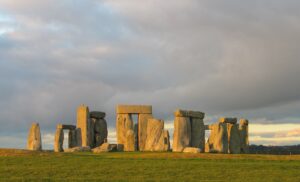
I heard a nice little piece about immersive archaeology on the radio recently. This comprises a new form of presentation of the past which makes use of gaming technology to reconstruct ancient sites and monuments as they might have appeared when in use. It includes additional atmospheric detail such as noise (or the lack of it in the case of traffic). Apparently, Dr Rupert Till from the University of Huddersfield has recreated the sounds of Stonehenge in a virtual tour that makes use of ancient instruments.
The radio interview noted that this was a controversial development in archaeology, making use, as it does, of supposition rather than fact. We can never know what the sounds of the Stone Age sounded like. They did go on to include a snippet from Aaron Watson, whose work I much admire, and he validated the project; but I felt that there was still an element of doubt and it got me thinking.
Firstly, the implied information that archaeology deals with ‘fact’. In reality, I can’t think of any interpretation in archaeology that is totally factual. We may record a burial – but we don’t know the precise details. Our assessment of the childhood home of the individual (if we make one) will be based on an evaluation of several possible matches for the isotopic detail gleaned from their teeth. Information relating to age will be based on an evaluation of the skeleton; diet, manner of death, burial rites: all similarly related to the evaluative skills of various specialists. We may record a stone circle – it is still impossible to be certain that every stone was in place at the same time, perhaps some had fallen before the last were erected. We record a structure – we interpret its function, even its appearance. We don’t know what it was used for, we guess. We put these elements together into a story in order to construct a human narrative. There is no such thing as archaeological truth.
Secondly, the nature of the narratives that we construct. If we base them on archaeological remains alone they will be sorry, monochrome, stories indeed. I am constantly amazed by how drab and grey archaeological finds tend to be. Not surprisingly, after several millennia buried in the earth, colour and texture tend to have disappeared. But our lives are not monochrome, and this is as true of the past as it is of today. If we are truly to build a narrative of the past, we have to consider those elements that no longer survive, elements such as sound, colour, sensation such as warmth and light.
To make the archaeological narrative work we have to fill in the gaps between the details we amass from archaeology. The trick is to fill those gaps with detail that is bounded within the realm of probability. Understanding where that realm lies is the job of the archaeologist and colleagues.
So, I say – excellent. I’m all for immersive archaeology. Yes, it leads us into supposition, but that is the nature of archaeology. It may be territory where we need to employ our interpretive skills a bit more openly than we do when working on a conventional archaeological report. But lets not kid ourselves: that report contains just as much doubt as the virtual reality headset or the phone app. As long as we base our scenarios in the available information then it does not matter if the story changes from time to time. We don’t really think that our word on a site is the definitive last word do we? People are always reappraising things in light of new information.
I’m not in archaeology just to talk to myself, or my colleagues (apologies to my colleagues). I’m in archaeology in order to make the past come alive for everyone. And I would be in dereliction of duty if I did not make use of all possible techniques to do this. Including new ones.
Virtual reality, immersive archaeology, soundscapes – bring them on. Hopefully they will soon become an integral part of the way in which we present the past – whether in museums, out on walks, perhaps even at home. It is so good to see people taking steps towards this.
You must be logged in to post a comment.